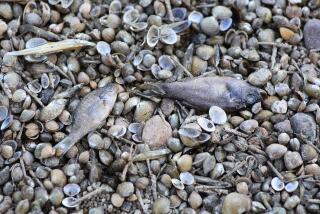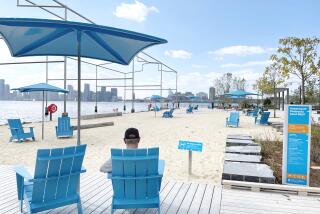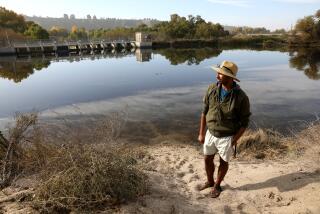Clear Waters, Anglers Return to New York City’s Rivers
- Share via
NEW YORK — Bundled up against bone-chilling cold, the two intrepid fishermen cast their lines into the swirling waters of the East River as traffic from a busy highway flowed nearby.
It was 11 degrees as they walked the promenade along the river’s edge in Manhattan, trying to keep warm.
“I am here almost every day,” said Peter Wright, 51, an air-conditioning repairman wearing a New York Rangers jacket with a hood pulled up over his ears. “I’m a die-hard fisherman.”
“My big catch is striped bass,” said his companion, Jose Rivera, 59, a construction worker sporting a bulky blue coat and woolen cap. “Sometimes we catch bluefish. . . . We get winter flounder, white perch, an occasional eel.”
In New York, where attention is focused on a sharp decline in crime--homicides dropped to 983 last year, the lowest figure in 28 years--there is another positive story: dramatic improvement in water quality.
Bass, not bodies, are being pulled from the city’s rivers.
“From the mid-1960s there has been a phenomenal cleanup of the Hudson River,” said Nicholas A. Robinson, head of the Center for Environmental Legal Studies at the Pace University School of Law. “The East River and the lower end of Long Island Sound are not terribly badly polluted. There is an active fishing area [there].”
“It certainly is cleaner,” added Cara Lee, environmental director of Scenic Hudson, a conservation group. “We point to the Hudson River as a Clean Water Act success story.”
The plunge in pollution, like the drop in crime, is rooted in activism.
Mayor Rudolph W. Giuliani’s administration has vigorously adopted the “broken windows” theories of UCLA professor James Q. Wilson and his co-author, George L. Kelling. The authors stress that street crime flourishes in neighborhoods where disorderly conduct and quality of life issues aren’t addressed.
Police have focused not only on major crimes, but also on such offenses as vandalism, prostitution, low-level drug dealing and even unauthorized squeegee operators, who wipe motorists’ windshields and then demand money for the service. The stress is on police presence. Crime statistics are measured every day, and officers are quickly deployed before problems grow.
Quick response and vigilance also are hallmarks of a highly organized network of environmental activists seeking to protect New York’s rivers. Through lawsuits and protests, toxic landfills and dumps near the Hudson River were closed. Firms that polluted the river were fined. Under pressure, power projects threatening water quality and marine life were halted.
A $1-billion Pure Water and Bond Act, sponsored by former Gov. Nelson A. Rockefeller in 1965, underwrote the cost of modern sewage treatment plants along the Hudson’s shores. That pioneering legislation was reinforced by the federal Clean Water Act of 1972, tightly controlling the disposal of industrial and municipal waste.
And although problems remain--nagging traces of chemicals restrict the number of fish that can be eaten--the result has been a renaissance of river life. Conservationists say 206 species of fish now live in the Hudson.
“There are more people fishing the East and Hudson Rivers because they are cleaner,” said Phil Koenig, owner of Manhattan Custom Tackle, a store catering to sophisticated anglers.
Urban fishing can provide solace from the stresses of big-city life. Standing by a river, even with the sound of traffic as background music can rekindle the bond with nature and the human spirit described hundreds of years ago by Izaak Walton in his 17th-century treatise, “The Compleat Angler.”
“You will find angling to be like the virtue of humility, which has a calmness of spirit, and a world of other blessings attending upon it,” Walton wrote.
But let’s not get carried away by humility. Bragging rights have hooked many a fisherman over the years.
“Fishing is nice,” said Wright as he stood by the East River, telling of the striped bass he caught in June: “39 1/2 inches. It was about 45 pounds.”
“I got pictures of the fish. I brag. The proof is in the pudding,” he said. “You know what I mean?”
More to Read
Sign up for Essential California
The most important California stories and recommendations in your inbox every morning.
You may occasionally receive promotional content from the Los Angeles Times.










